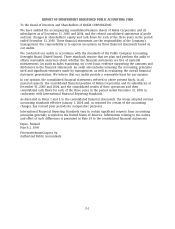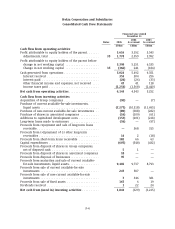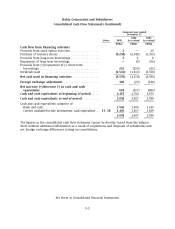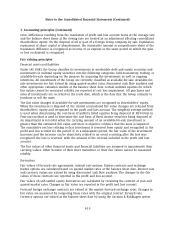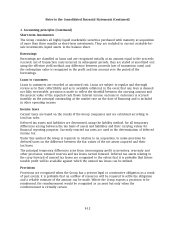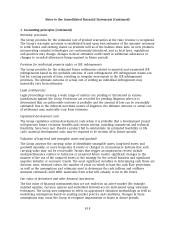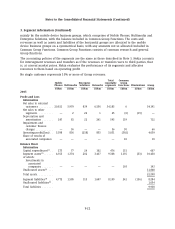Nokia 2005 Annual Report Download - page 149
Download and view the complete annual report
Please find page 149 of the 2005 Nokia annual report below. You can navigate through the pages in the report by either clicking on the pages listed below, or by using the keyword search tool below to find specific information within the annual report.Notes to the Consolidated Financial Statements (Continued)
1. Accounting principles (Continued)
valuation model. Changes in the fair value on these instruments are reported in the profit and loss
account except to the extent they qualify for hedge accounting.
Embedded derivatives are identified and monitored in the Group and fair valued at the balance
sheet date. In assessing the fair value of embedded derivatives the Group uses a variety of
methods, such as option pricing models and discounted cash flow analysis, and makes
assumptions that are based on market conditions existing at each balance sheet date. The fair
value changes are reported in the profit and loss account.
Hedge accounting
Hedging of anticipated foreign currency denominated sales and purchases
The Group applies hedge accounting for ‘‘Qualifying hedges’’. Qualifying hedges are those properly
documented cash flow hedges of the foreign exchange rate risk of future anticipated foreign
currency denominated sales and purchases that meet the requirements set out in IAS 39(R). The
cash flow being hedged must be ‘‘highly probable’’ and must ultimately impact the profit and loss
account. The hedge must be highly effective both prospectively and retrospectively.
The Group claims hedge accounting in respect of certain forward foreign exchange contracts and
options, or option strategies, which have zero net premium or a net premium paid, and where the
critical terms of the bought and sold options within a collar or zero premium structure are the
same and where the nominal amount of the sold option component is no greater than that of the
bought option.
For qualifying foreign exchange forwards the change in fair value that reflects the change in spot
exchange rates is deferred in shareholders’ equity to the extent that the hedge is effective. For
qualifying foreign exchange options, or option strategies, the change in intrinsic value is deferred
in shareholders’ equity to the extent that the hedge is effective. In all cases the ineffective portion
is recognized immediately in the profit and loss account. Hedging costs, either expressed as the
change in fair value that reflects the change in forward exchange rates less the change in spot
exchange rates for forward foreign exchange contracts, or changes in the time value for options,
or options strategies, are recognized within other operating income or expenses.
Accumulated fair value changes from qualifying hedges are released from shareholders’ equity
into the profit and loss account as adjustments to sales and cost of sales, in the period when the
hedged cash flow affects the profit and loss account. If the hedged cash flow is no longer expected
to take place, all deferred gains or losses are released into the profit and loss account as
adjustments to sales and cost of sales, immediately. If the hedged cash flow ceases to be highly
probable, but is still expected to take place, accumulated gains and losses remain in equity until
the hedged cash flow affects the profit and loss account.
Changes in the fair value of any derivative instruments that do not qualify for hedge accounting
under IAS 39(R) are recognized immediately in the profit and loss account. The fair value changes
of derivative instruments that directly relate to normal business operations are recognized within
other operating income and expenses. The fair value changes from all other derivative
instruments are recognized in financial income and expenses.
F-11


